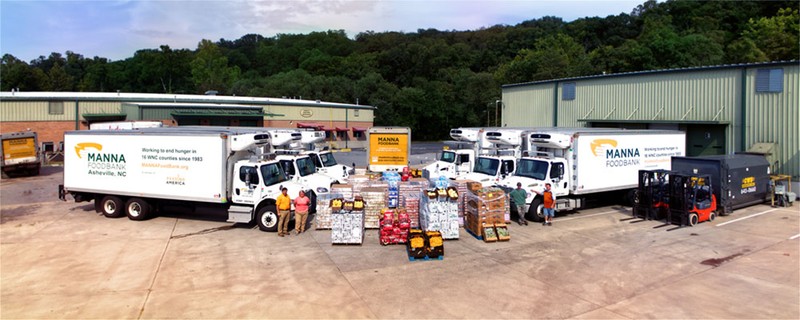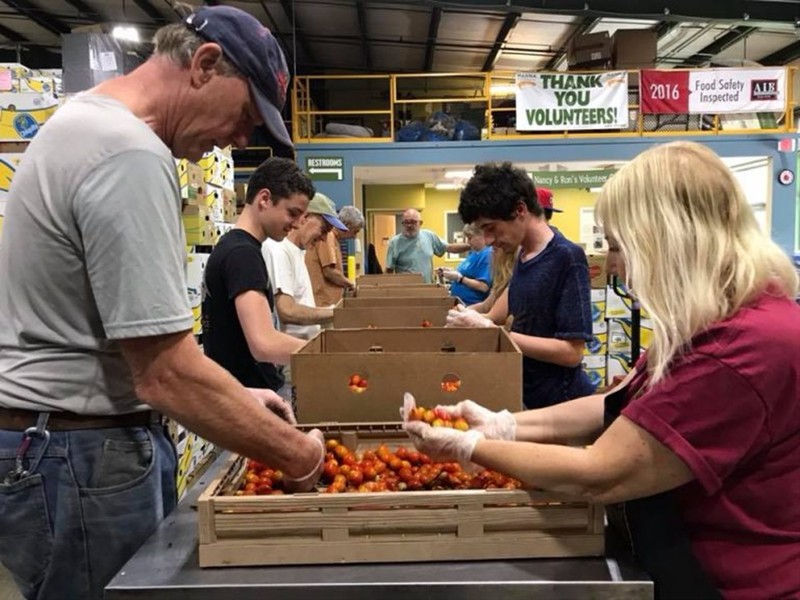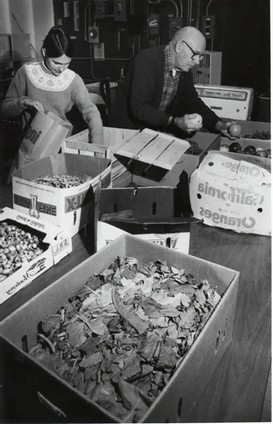Manna Food Bank
Introduction
Text-to-speech Audio
Manna is a emergency food aid/food bank system that mainly operates in the Appalachia region. The headquarters are located at 627 Swannanoa River Road, Asheville, NC 28805-2445. They have been providing food to those in need the area since 1982 to the present day. This organization was originally founded by the Hunger Awareness group in Asheville, North Carolina, but food distribution came from the help of Eliada Home for children in 1983. Food Banks are important in areas like the one MANNA provides in because food insecurity can be very high in these areas and organizations like MANNA help people achieve a more constant source of food security. MANNA is publicly accessible throughout its many locations within the greater Appalachia region.
Images
In this picture, we see how the organization MANNA Food Bank is prepping trucks to get ready to distribute food to those who are food insecure in the community at the moment. We can see just how much people have donated and how much will be sent out.

In this picture, we see how Volunteers are inside a MANNA Food Bank location helping to sort produce out. This picture shows how many people there are actively trying to help those who are food insecure at the moment. They all care about their community.

Volunteers line up outside of the MANNA Food Bank location in order to provide the help and manpower they need to process all the donated foods and get them prepped to be given away. They do this despite the limited time in their days to help out their community.

These are workers from the early days of MANNA Food Bank separating the good and bad produce in order to prep the food to be ready for food distribution. These are only a few of the workers that decided to help back then.

Backstory and Context
Text-to-speech Audio
The world has been in dire need of emergency food aid in recent days. With big events like civil wars, natural disasters, financial problems, and more can hit certain areas harder. Especially areas that are more rural and farther away from more urban areas [CD1] like the Appalachia region. However, a certain food bank in North Carolina is helping to combat this. MANNA (Mountain Area Nutritional Needs Alliance food bank) has been on this since 1983, helping these communities with food insecurity and more. Emergency food aid is an essential part of society because how it helps rebuild communities, provides hope for these communities, helps the economy, and helps save lives.
Emergency food aid is an essential part of society because of how it helps rebuild communities. One of America’s biggest problems at the current moment is poverty. During the COVID-19 pandemic, Barr discusses in his article how due to early-stage lockdowns and jobs being shut down due to health concerns, many families found themselves below the poverty line. They would struggle to pay basic utility bills, and more importantly, they would struggle to pay for food. (Barr, 2021). And this was specifically seen in the Appalachia region that MANNA works in. Rural areas like these were hit the hardest when the pandemic hit. However, even with the negative effects poverty might have on families, food helps to bring people together; both the people needing it and the people that are helping to provide the food. It’s visible to see how when MANNA works to bring food to people, it has a positive impact on its community as well; wouldn’t this be the same for other areas in the world? Calderwood discusses in her article how the FAC (The Food Assistance Convention) does the same for other countries in the world as well. It’s not just MANNA making a difference in their areas, other countries are trying to do it as well. A local newspaper article in the Appalachia region discusses how MANNA gets support from various organizations in its communities, one of which is IAM (Interfaith Assistance Ministry). From one food bank alone, the amount of support they get from their community is enormous.
Another reason why the MANNA food bank is so important to society is how it brings hope to the Appalachia community. When you think of people who need emergency food aid, you would usually think of people suffering from natural disasters, poverty, health crises like COVID-19, etc. Jonathan Ammons discusses how for those in the Appalachia regions, during the government shutdown back in 2018-2019, families had to rely more on SNAP benefits (modern-day food stamps) for food; but even this didn’t help food from being sent to tables (Ammons, 2019). Manna has tried their best to mitigate these conditions the best it can, but it’s still a problem for MANNA to be able to have the right amount of food for people at the right time. During the COVID-19 pandemic, things got even harder for those living in the Appalachia community due to the rising costs of food which directly affects the food donation rate for MANNA (Smith, 2022). But for people in these communities, MANNA not only gives them hope, it also helps them make a difference in their own communities. MANNA helps people destress from realities such as “will I be able to put food on the table for my family”, worsening mental health because of food insecurity, etc. Food insecurity can have such a huge impact on people’s health, both mentally and physically, that it’s important for MANNA and other food organizations to be able to help their communities out when needed.
Another reason why organizations like MANNA food bank are essential to society is due to how it helps the economy. If the communities that MANNA is helping were to be stable food-wise, it would help lessen the burden of food costs for MANNA. Smith notices how due to the pandemic, things like food prices have significantly increased due to pandemic-related issues; things like the Bird Flu (which raised prices of eggs, poultry, and turkey), worker shortages, and more. Obstacles like these have only helped to increase the burdens of MANNA and their battle for being able to provide for as many people as they can; during the pandemic and after it. During the federal government shutdown of late 2018-2019, one of the hardest hit states food wise was hit the hardest, being the 8th most food insecure state in 2015 (by a survey from the USDA). MANNA had to scramble everything they had at the time to make ends meet for this situation. If they were even a tiny bit short of food to send out, it would have been a disaster for those in the Appalachia community (Ammons, 2019). This puts an emphasis on how to lessen any burdens placed on MANNA to help more communities in need. An article by the magazine Migration World discusses the increasing prices of grain back in 1994-1995 and how it only went higher. This would cause a slew of domino effects in modern times, especially for smaller regions like Appalachia. Increased prices of grains would cause the shipping prices to increase as well, making the final price higher than it should be and harder for organizations like MANNA to buy food for its communities to help them.
A final reason why MANNA is an essential part of society is due to how it saves lives. One of the biggest groups of people who receive emergency food aid from MANNA is those with health dilemmas. Barr discovered in a survey nationwide how during the pandemic, most people receiving food aid from organizations like MANNA were diagnosed with chronic health problems like anxiety, being overweight, etc. (Barr, 2021). This shines a light on the harsh effects food insecurity has on people’s health. It’s important to help MANNA and other food banks to give proper food out to those who need it to get them healthier. In smaller cases like the area that MANNA surrounds, COVID-19 stopped producers, shippers, farmers, and more from producing food and sending it to MANNA to distribute. Without MANNA’s food, families might start to suffer serious health effects. However, MANNA and its food banks can help people get back on their feet. Calderwood discusses how Food aid could become long-term in the future. Food aid could help areas where food shortages might exist and help create more food security for families (Calderwood, 2018). We could break the patterns of food insecurity and shortages in the Appalachia region if MANNA got more funds and donations to work off. They would flip the script 180 degrees.
In conclusion, I absolutely think emergency food aid is an essential part of society because of how it can help rebuild communities, provide a ray of hope for these communities, helps the economy, and helps save lives. We can see how organizations like MANNA are undoubtedly making a good change for the community in which they work. If this were to keep happening, there might be a serious chance of ending the need for emergency food aid at. However small MANNA may be, they are still leaving being a ginormous footprint left to be followed by others in the future.
Sources
Barr, Makenzie L, Kendra OoNorasak, Kristin Hughes, Lauren Batey, Kaela Jackson, Haley Marshall, and Tammy Stephenson. “Exploring Perceived Importance of a Novel Emergency Food Program during COVID-19 and Program Recipient Characteristics.” International journal of environmental research and public health. MDPI, October 14, 2021. https://www.ncbi.nlm.nih.gov/pmc/articles/PMC8535328/.
Calderwood, Imogen. “How Aid Helps the 76,000,000 People Who Don't Have Enough Food.” Global Citizen, April 4, 2018. https://www.globalcitizen.org/en/content/follow-the-food-aid-how-it-works/#:~:text=At%20its%20most%20basic%2C%20it,immediately%20following%20a%20natural%20disaster.&text=Food%20aid%20can%20also%20be%20more%20long%2Dterm%2C%20however.
“Emergency Food Aid: Part of a Larger, Continuing Problem.” 1996. Migration World 24 (4): 33–33.
Hoxie, Philip G, Stephanie Mercier, and Vincent H Smith. 2022. “Food Aid Cargo Preference: Impacts on the Efficiency and Effectiveness of Emergency Food Aid Programs.” Journal of Law & Economics 65 (2): 395–421.
Randall, Hannah. “Sidebar: Climbing with Hope: How Food Banks and Community Came Together in Covid-19.” North Carolina Medical Journal 82, no. 4 (July 1, 2021): 262–63. https://doi.org/10.18043/ncm.82.4.262.
Search, Henrietta. 1986. “Emergency Food Aid from the European Community.” Disasters 10 (4): 247–49. https://doi.org/10.1111/j.1467-7717.1986.tb00599.x
Smith, Christian. “High Price of Food, Gas Putting a Strain on Manna, Local Food Pantries.” Hendersonville Times-News. Hendersonville Times-News, April 24, 2022. https://www.blueridgenow.com/story/news/2022/04/24/nc-rising-costs-gas-strains-manna-food-bank-local-pantries/7369385001/.
